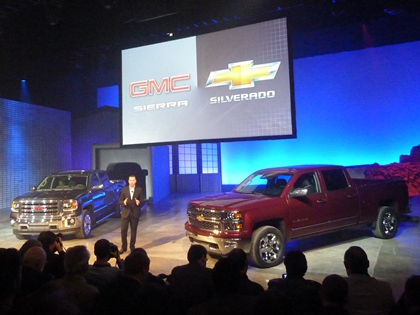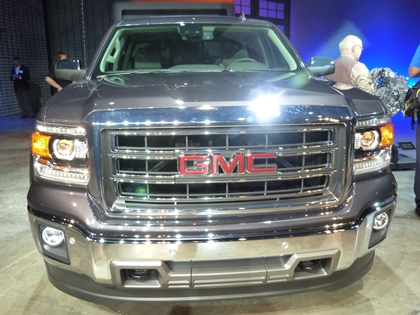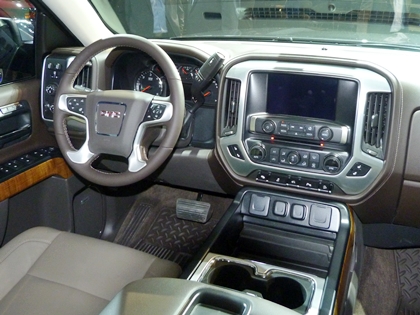I haven’t reviewed a full-size pickup in years because I assume that my tastes are so different from those of the typical pickup buyer. My review simply wouldn’t be relevant to them. Or so I thought. I might be wrong.
 Today I attended the reveal for GM’s redesigned full-size pickups, the Chevrolet Silverado and GMC Sierra, which will launch next spring as early 2014 models. For the most part the presentations were the usual “more of everything.” Whatever people might want in a truck, these new pickups will have more of it. In particular, they’ll have more power (the actual specs to be revealed next year) and better fuel economy courtesy of a combination of direct injection (enabling high compression), variable cam timing (with a single cam still in the block), and seamless cylinder deactivation (both the 4.3-liter V6 and the 5.3-liter and 6.2-liter V8s will cruise on only four cylinders). They have more functionality courtesy of bigger, easier to used knobs and switches, more interior storage spaces than ever, steps built into the rear bumper, and LEDs built into the bed (to assist when loading and unloading in the dark). A torsion rod built into the tailgate makes for easy, slam-free opening and closing. The rear doors on the extended cab are now, as on the RAM, forward-hinged, for easier entry and exit They have more comfort in the front seats via dense, higher quality foam. (Likely for cost reasons, the rear seats remain relatively soggy.) They have more luxury in thoroughly upholstered door panels and stitching on the instrument panel. The “aluminum” trim in the GMC is actually aluminum. The superior quietness of these trucks was stressed more than anything else during the presentations.
Today I attended the reveal for GM’s redesigned full-size pickups, the Chevrolet Silverado and GMC Sierra, which will launch next spring as early 2014 models. For the most part the presentations were the usual “more of everything.” Whatever people might want in a truck, these new pickups will have more of it. In particular, they’ll have more power (the actual specs to be revealed next year) and better fuel economy courtesy of a combination of direct injection (enabling high compression), variable cam timing (with a single cam still in the block), and seamless cylinder deactivation (both the 4.3-liter V6 and the 5.3-liter and 6.2-liter V8s will cruise on only four cylinders). They have more functionality courtesy of bigger, easier to used knobs and switches, more interior storage spaces than ever, steps built into the rear bumper, and LEDs built into the bed (to assist when loading and unloading in the dark). A torsion rod built into the tailgate makes for easy, slam-free opening and closing. The rear doors on the extended cab are now, as on the RAM, forward-hinged, for easier entry and exit They have more comfort in the front seats via dense, higher quality foam. (Likely for cost reasons, the rear seats remain relatively soggy.) They have more luxury in thoroughly upholstered door panels and stitching on the instrument panel. The “aluminum” trim in the GMC is actually aluminum. The superior quietness of these trucks was stressed more than anything else during the presentations.
 GM stresses that the Chevrolet and GMC are more differentiated than ever. Nevertheless, they continue to look far more like one another than either does to a Ford or a RAM. The key differences are the aforementioned aluminum trim, blue vs. red interior lighting, and the front end styling. Is this enough to justify two separate brands? Probably not, but since GM already has them might as well use them. Both brands described their target buyer. It turns out that both target buyers have neat, well-organized garages. The GMC buyer just takes this up another level. Large pickup buyers with messy garages, like car buyers who don’t have active lifestyles, receive no love.
GM stresses that the Chevrolet and GMC are more differentiated than ever. Nevertheless, they continue to look far more like one another than either does to a Ford or a RAM. The key differences are the aforementioned aluminum trim, blue vs. red interior lighting, and the front end styling. Is this enough to justify two separate brands? Probably not, but since GM already has them might as well use them. Both brands described their target buyer. It turns out that both target buyers have neat, well-organized garages. The GMC buyer just takes this up another level. Large pickup buyers with messy garages, like car buyers who don’t have active lifestyles, receive no love.
What don’t the new pickups have? Well, unlike with the RAM you won’t be able to get a height-adjustable air suspension or storage compartments built into the sides of the bed. Unlike with the Ford you won’t be able to get the alleged superior efficiency of a turbocharged engine. In general, there are no major, potentially game-changing innovations. Even the exterior styling is similar to the previous truck, just more refined and with more advanced headlights (gotta have LEDs). This was somewhat disappointing to the writer in me, as writers focus on the “new.”
Potentially more of an issue is that the interiors, despite the upgrades, don’t seem as luxurious as those in the top-level Fords and Dodges. The aluminum in the GMC might be real, but it looks no more real than the fake stuff in the Chevrolet. It doesn’t help that the black plastic trim plates, switches, and knobs circumscribed by the aluminum appear very basic, to put it mildly. The center stack is also unfashionably far from flush and crisp. Having the large buttons and knobs clearly separated into different areas should greatly aid ease of use, but it doesn’t appear sophisticated or pretty.
 Why should “sophisticated and pretty” matter in a pickup? For the same reason the new trucks’ quietness is such a big deal. Many large pickups are bought as luxury car substitutes, with a third selling for over $40,000. Crew cab pickups are now about 60 percent of the market, while regular cabs are only about 10 percent. How many are still bought to serve frequently as trucks? Neither the Chevrolet nor the GMC executives could say. They don’t really know. They’ve asked owners, but few will admit to not using their truck as a truck. Both groups of marketers stressed that the buyers demand capability because they like knowing it’s there if they do need it. This isn’t unique to the pickup market. How many Jeep owners frequently use the off-road capability of their vehicles? How many high-performance sports car owners frequently use the capability of theirs? Beyond cars, how many Rolex watches are used for diving far beneath the ocean’s surface? But all of these groups want “the best” even if they will rarely if ever actually need it.
Why should “sophisticated and pretty” matter in a pickup? For the same reason the new trucks’ quietness is such a big deal. Many large pickups are bought as luxury car substitutes, with a third selling for over $40,000. Crew cab pickups are now about 60 percent of the market, while regular cabs are only about 10 percent. How many are still bought to serve frequently as trucks? Neither the Chevrolet nor the GMC executives could say. They don’t really know. They’ve asked owners, but few will admit to not using their truck as a truck. Both groups of marketers stressed that the buyers demand capability because they like knowing it’s there if they do need it. This isn’t unique to the pickup market. How many Jeep owners frequently use the off-road capability of their vehicles? How many high-performance sports car owners frequently use the capability of theirs? Beyond cars, how many Rolex watches are used for diving far beneath the ocean’s surface? But all of these groups want “the best” even if they will rarely if ever actually need it.
So, as far as Chevrolet and GMC are concerned, it doesn’t really matter how many buyers will use the trucks as trucks. All of them want a highly capable truck, so this is what GM has focused on providing. With quietness.